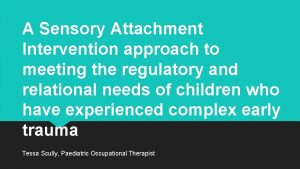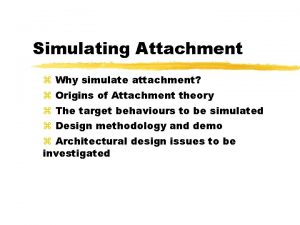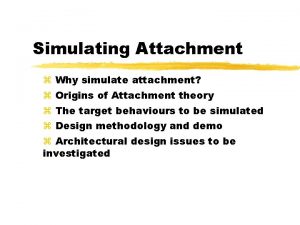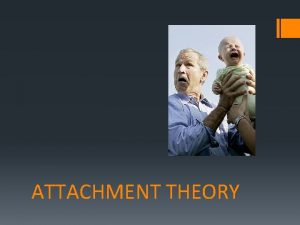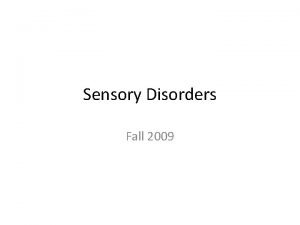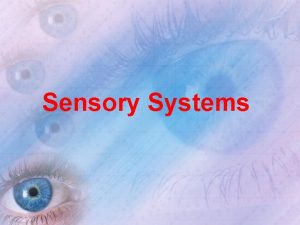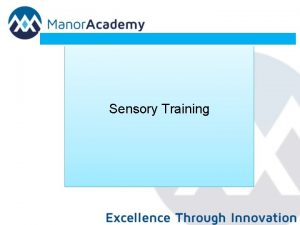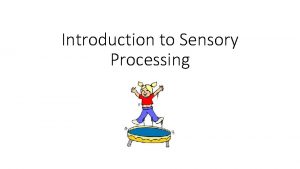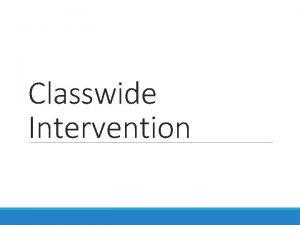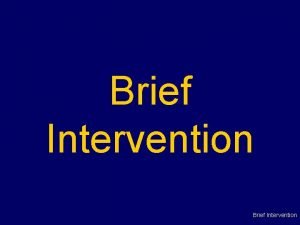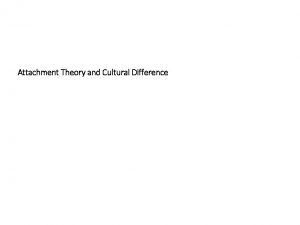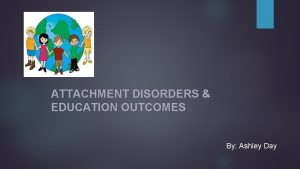A Sensory Attachment Intervention approach to meeting the
















- Slides: 16

A Sensory Attachment Intervention approach to meeting the regulatory and relational needs of children who have experienced complex early trauma Tessa Scully, Paediatric Occupational Therapist

Reasons for behavior Background information Childhood Trauma (Perry) Attachment Theory (Crittenden) Polyvagal Theory -The ‘Social engagement ‘system (Porges) Sensory Processing Patterns

Sensory Attachment Intervention (SAI) SAI was developed by Eadaoin Bhreathnach, Occupational Therapist and Attachment Counsellor (Ireland). SAI is a parent child engagement approach, which is a reciprocal and mutually regulating process. Facilitates self-regulation and co-regulation between the parent/carer and the child. Focus is on regulation of arousal states and helping the child feel safe. Focus is on provision of therapeutic spaces which are regulating and meet the child’s sensory and attachment needs.

Childhood Trauma When we feel safe, we feel calm. Neurosequential Model of Therapeutics (Perry), the brain organises in a hierarchial order from lower brain functions to higher level functions. The brain is use dependent. Activities of a regulating nature that happen in a patterned, predictable and repetitive way will have a regulating effect on the brain.

Attachment Theory –DMM Model Drawing on the work of Patricia Crittenden and the Dynamic Maturational Model of Attachment DMM informs us of the attachment seeking or avoiding strategies that are the child has learnt to utilise as an infant in order to have their needs met and reduce danger. These strategies change throughout the lifespan and may differ with different caregivers.

Polyvagal Theory The Polyvagal theory proposes a third branch to the Autonomic Nervous System which considers how emotional states, facial gestures, vocal expression and other non verbal signals lead to regulation. Neglect suppresses development of the child’s “social engagement “system (Porges). When we feel safe and connected with, survival behaviours switch off and we are able to better regulate our emotional responses and access higher level brain functions (executive functioning).

Sensory Processing Children with developmental trauma regularly have altered responses to sensation, this may be over responsiveness to certain types of stimuli, under responsiveness to other types of sensory input or a fluctuating response to sensation. They can also find it hard to discriminate types of sensation. Responses may be altered due to developmental difficulties, lack of stimulation and interaction or traumatic experiences. Traumatic experiences can lead to distorted sensory responses and these responses can continue beyond the period of being exposed to the trauma. (Bhreathnach)



Implications for intervention Regulate arousal states before embarking on approaches which utilise higher level brain functions such as those requiring reflective function – such as life story work, narrative therapy, DDP… An SAI approach guides interpretation of a child’s dysregulated behaviours and considers the stress and attachment bias of the child and the associated sensory processing patterns. Principles for regulating the child are selected according to the bias the child presents with. This can in turn facilitate other approaches and models of working with traumatised children.

The Just Right State Children and Parent’s Programme Use of sensory activities and foods to help children learn how to self regulate their emotional states and behaviours. The “Scared Gang” characters are introduced which represent different survival patterns of behaviour. The different characters tell the children how they react to situations and what each of them does to achieve the “Just Right State”. Goals of the programme include to enable children to become more emotionally aware of themselves and others, to give them simple tools to enable them to self regulate and achieve the ”Just Right State”, whether it is to engage in academic learning, interacting with their peers, or to be able to get a good nights sleep.

Parents Programme Parents and carers learn the principles behind the children’s activities and about their patterns of survival through the Scared Gang They discuss their child’s behavioural problems and their goals for their child. Parents are helped to complete a Sensory-Emotional Profile questionnaire and each week are provided with home and outdoor activities that are tailor made for their child’s sensory attachment pattern.

Self care and self nurture for carers/ parents Parents and carers are also taught strategies to manage their stress levels. The idea of the programme is to enable parents to provide an enriched environment within the home which facilitates the core components of successful parent child engagement, that is the capacity to self regulate and mutually regulate.

Training Pathways Social workers, psychologists, teachers and other allied social care professionals regularly train to become facilitators of the Just Right State Children and Parent’s programme. This is a 4 day training which to attend must be preceded by attendance at the 2 day introductory training Sensory Processing, Trauma and Attachment. Occupational therapists can be trained as Sensory Attachment Intervention therapists who will analyse sensory and attachment patterns, facilitating parent-child engagement sessions and debriefing parents/carers following micro-analysis of parent-child interactions in sessions.

Just Right State Programme (JRS) The JRS group programme is being facilitated in a range of settings in the UK, Ireland Australia by different professionals including LAC and adoption services, some CAHMS teams are using this approach facilitating group programmes with very positive results and feedback from children and families. Mainstream schools have teachers trained to facilitate groups. Two trained facilitators are required to run groups.

JRS in Schools One Social Emotional Mental Health (SEMH) school in the UK has recently embraced a school wide JRS approach where the children engage in the physical part of the programme daily, do a weekly session related to learning about regulating their emotional states and are beginning to integrate SAI principles across the curriculum. Outdoor spaces have been developed in accordance with the principles of the SAI model. Preliminary research is occurring in analysing ECG responses in children who are participants of the JRS programme to analyse correlations between stress, attachment and sensory patterns.
 Sensory attachment intervention
Sensory attachment intervention Intervention mapping approach example
Intervention mapping approach example Types of meeting
Types of meeting Today meeting or today's meeting
Today meeting or today's meeting Today meeting or today's meeting
Today meeting or today's meeting What is meeting and types of meeting
What is meeting and types of meeting Waterfall market entry strategy
Waterfall market entry strategy Diagram for traditional approach
Diagram for traditional approach Multi approach avoidance conflict
Multi approach avoidance conflict Tony wagner's seven survival skills
Tony wagner's seven survival skills Difference between virtual circuit and datagram subnet
Difference between virtual circuit and datagram subnet Bandura's reciprocal determinism
Bandura's reciprocal determinism Cognitive approach vs behavioral approach
Cognitive approach vs behavioral approach Research design definition
Research design definition Phép trừ bù
Phép trừ bù Thơ thất ngôn tứ tuyệt đường luật
Thơ thất ngôn tứ tuyệt đường luật Chúa yêu trần thế alleluia
Chúa yêu trần thế alleluia
